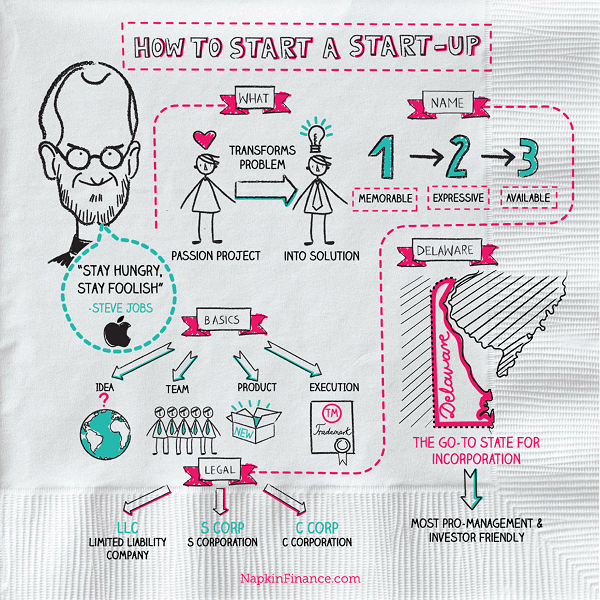9 Things Small Business Owners Need to Know
By Rieva Lesonsky
1—How to Avoid a Cash Flow Crisis
According to U.S. Bank, 82% of small businesses fail due to poor cash flow management. Scott Notarainni, the Managing Director of Corporate Finance at FTI Consulting created the infographic below to help you avoid that fate.

2—State of the Market: EMV Chip Migration
Earlier this year, the U.S. Payments Forum released a 2017 market snapshot, providing updates on the status of the U.S. EMV chip migration, 2017 priorities for accelerating merchant chip enablement and securing the card-not-present channel, and recently-released resources for the payments industry.
There has been steady progress in the U.S. migration to chip payments. Today, 9 out of 10 Americans are commonly using chip cards at the approximately one-third of U.S. merchant locations enabled to accept chip payments, and an estimated 79% of ATMs will have completed the migration by the end of this year. In 2017, the U.S. Payments Forum will continue to address issues that arise from those parts of the ecosystem that have implemented EMV, and provide education and implementation guidance to merchant segments that have unique and/or challenging migration paths.
Trending Topics: EMV in the Petroleum Environment: At the end of last year, American Express, Discover, Mastercard and Visa individually announced modified timelines for their respective EMV fraud liability shift policies for automated fuel dispensers in the U.S. The petroleum industry policy changes that were slated to take effect in October 2017 will now take effect in October 2020.
Addressing the Card-Not-Present Environment, Mobile Payments: In addition to aiding the chip migration to reduce in-store counterfeit card fraud, the U.S. Payments Forum is prioritizing the importance of addressing fraud in the card-not-present (CNP) environment in online and mobile channels. In addition, the Forum is launching projects to address the challenges with implementing mobile payments, taking an inclusive cross-industry view to address issues that impact multiple stakeholders.
EMV testing and certification. The Forum updated the “EMV Testing and Certification White Paper: Current Global Payment Network Requirements for the U.S. Acquiring Community.”
The Forum also launched the Mobile and Contactless Payments Working Committee to explore opportunities and challenges, identify possible approaches, and develop practical implementation guidance and best practices for the variety mobile and contactless payments solutions being implemented in the U.S.
To learn more go here.
3—5 Tips for Working with Remote Sales Reps
Guest post by Eliot Burdett, author, sales recruiting expert and cofounder CEO, Peak Sales Recruiting
The advent of new technology and changing philosophies on work life balance, have created an increasingly mobile work force. Last year, the Global Leadership Summit predicted more than half of all employees will work remotely by 2020.
This will have a profound impact across all industries but perhaps even more so in sales. Sales people thrive on energy, engaging with others and they need to be motivated on a daily basis.
Companies that used to have a centralized sales force have a whole new set of opportunities and challenges when managing a remote team. The ability of sales leaders to solve these will be the difference between a cohesive team that consistently makes their numbers, and one that is isolated, disjointed and hurting the company’s profit margins.
Here are 5 tips to make a remote sales rep connected and successful:
- Communicate often and on a personal level: Research from the Journal of Personal Selling & Sales Managementexplains that workplace isolation negatively effects trust in supervisors and coworkers. Making your reps deal with rejection on an island is a recipe for disaster. This can be overcome with frequent and informal check-ins. Rely on teleconferences or even text messaging to communicate with your team. The constant communication will help lessen feelings of isolation. In addition, we recommend connected with your reps on an individual level. By asking about their favorite sports team or their child’s graduation you will make them feel a strong connection to you, their leader, your company and their mission. It is just as critical to set up peer-to-peer teleconferences. Sometimes, a ‘players-only’ meeting is just what the doctor ordered.
- Budget for social engagements: A sales rep who feels isolated is doomed to fail. Harvard Business Review reported successful managersof remote sales teams organize face-to-face forums, conferences, workshops and get-togethers. These are planned well in advance and, in addition to building cohesion at work, this gives employees a chance to interact socially, which is critical to building rapport. A good option could be to choose a sales conference to attend together. Plan this into your budget and the investment will pay off in both the short and long term.
- Make your availability crystal clear:Make it clear to your team via a shared calendar or team project management board when you are available. This sets clear guidelines for how and when you will respond to phone calls, e-mails, or texts. Having reps who feel like they can reach out to you in any given circumstance is crucial for leading a top producing team. This is especially necessary when managing across different times zones. If you are home with your family but it is still office hours on the West Coast or overseas, let your reps know how to reach you with emergencies.
- Use your reps’ autonomy to develop trust:The lack of face-to-face communications can hinder employee engagement. A study conducted by the Journal of Personal Selling and Sales Management found that employee engagement is shown to be positively correlated to salesperson job performance. To that point, Forum’s recent Global Leadership Pulse survey revealed that trust has a direct impact on the engagement levels of remote teams. Great sales managers, if handled properly, can use the autonomy of their reps to build trust. By giving reps the chance to take on additional responsibilities in certain situations they will feel empowered, engaged and connected—despite the distance.
- Don’t just hire any sales superstar: A common mistake in sales hiring is not hiring based on a certain situation. The assumption is that if someone was good in another selling environment, they will thrive in yours. That is a mistake. Find someone with the right sales DNA who has proven success working remotely.
The bottom line is that the evolution of technology has created an opportunity for businesses to profit from cultivating a remote workforce. However, it is incumbent on you to recognize that the same old rules don’t apply. Tactics such as developing trust, tweaking your communication approach and scheduling social events, can ensure long lasting relationships that will be profitable for your organization.
4—5 Tips for Succeeding in 2017
Guest post by Jamie Wright, an attorney specializing in Millennial issues (she’s a Millennial herself), government affairs, crisis communication and conflict resolution.
- Network. Many people think it’s a weakness to get help from people. That’s just not true. It takes a strong person to seek out the right kind of support. Get to know successful people in your chosen field, so you can get support and advice from them. If you are lucky enough to find a mentor, take good notes. Take the support and advice now, knowing that someday you will be in the position to provide it to someone else. While you surround yourself with good connections, never cease to be independent. Independence and being strong enough to move forward even if you are taking the next step alone is crucial in being successful.
- Think positive. Often, we get in our own way, because our minds are consumed with negative thinking. Focus on what you want, not on what you don’t want, and immediately replace negative thoughts with positive ones. Use the laws of attraction to bring to you what it is that you want in your life.
- Banish excuses. Too often, people are caught up in their own excuses for why they can’t do things. This year, get honest with yourself as to whether something really is a hurdle, or just an excuse. Banish the excuses and keep moving forward. Make individuality a priority, so you leave the excuses behind, define who you are, and stand out.
- The Golden Rule. In all areas of life, including in your career pursuits, you should be treating people the way you want to be treated. The way you treat people will always come back to you. Put good things out, so that good comes right back to you. It feels good to treat people with kindness and will open many doors. Having integrity in all you do is important and will help you get ahead.
- Forget expectations. It doesn’t matter if something has always been done a particular way, that’s not a legitimate reason why you can’t change it. In other words: Blaze your own trail, don’t feel you need to stick to the ones that others before you have set forth. Use your instincts to help navigate your way.
It’s easy to get caught up in the negative and just add to the stories and thoughts that hold people back. Make this the year where you set concrete goals, take steps every day to work toward achieving them, and drown out the noise that can hold you back. If you want it, you can succeed, but you have to stay the course and persevere. It will be that much sweeter once you do!
5—The Importance of Business Meals
Guest post by Sharon Schweitzer, J.D., a cross-cultural consultant, international protocol expert and founder of Protocol & Etiquette Worldwide.
Business meals are more than just talking shop—they are a way to distinguish your demeanor from the dinner table to the boardroom. You can be the best in your field or tops in your company, but if you mess up the business meal, no one is going to be impressed. What do you need to know about modern table manners to make a great impression?
Here are seven business dining tips to present yourself in the best manner possible.
1) Invitations: Remember that the person extending the invitation is the host and is responsible for payment of the bill. When receiving or extending invitations, pay attention to special dietary needs. The host may ask about food allergies or sensitivities, kosher, halal, gluten-free, sugar-free and dairy-free diets. Be sure to RSVP or reply within 24 hours with any dietary restrictions.
2) Guest Duties: As a guest, observe the host for cues. For example: place your napkin in your lap after the host; the host does so first to signal the start of the meal. When excusing yourself between courses, the napkin is placed on the chair seat soiled side down. At meal’s end, place your loosely folded napkin on the left of your plate after the host does. Don’t refold it.
3) Silverware & Service Signals: Once silverware is used, including handles, it doesn’t touch the table again. Rest forks, knives and spoons on the side of your plate. Unused silverware stays on the table. If you are resting between bites, place your fork, with tines up, near the top of your plate. To signal the server that you’re finished, place your fork and knife across the center of the plate at the 5 o’clock position. Service signals also include closing your menu to indicate you’re ready to order. If you are browsing an open menu, the server has the impression you aren’t ready.
4) What should you order? Ask the person who invited you for suggestions on the menu. Ask them to make suggestions or for their favorite dish. Listen carefully because they will provide a top and bottom price range based on the entrées they recommend. Then select a moderately priced item or one of the dishes they recommend.
5) To drink or not to drink? If the host orders alcohol, and you don’t wish to drink, you simply order the beverage of your preference without an explanation. “I’ll have an iced tea with lemon please” or “Diet Coke please” and continue to browse the menu. You are under no obligation to consume alcohol at lunch or any other time of the day. Polite dining companions will not comment or ask questions.
6) Connections & Conversation: It’s the host’s job to keep conversation going during the meal; and guests must contribute with courtesy. Just don’t monopolize the conversation, rather ask questions and express interest. Light topics include books, travel, vacation, movies, and pets; avoid politics, sex and religion. If you need to talk to the server, don’t interrupt the flow of the conversation. Rather catch the eye of the server if you need assistance, or slightly raise your hand.
7) Tipping: The host is the person who extended the invitation, and they are responsible for paying the bill. Consider these U.S. tipping guidelines: bartender: 10-20 % of bar bill, valet: $2.00-$5.00, coat check: $1.00 per coat, server: 15-20% of bill; 25% extraordinary service, sommelier: 15% of wine bill. The tip should reflect the total price of the bill before coupons, discounts, or gift certificates.
6—Seeing Green
If you’re an online retailer you might have overlooked the opportunity St. Patrick’s Day brings you. According to the National Retail Federation, consumers projected to spend $5.3 billion to celebrate the March 17 holiday (an all-time high in the survey’s 13-year history), but 7% of adults also plan to make a St. Patrick’s Day purchase online. While it’s likely too late to take advantage of the advice below, file this away in time to prepare for next year’s holiday.
Joey Blanco, the Content & Social Media Coordinator at ShipStation shares some tips to maximize your online store’s St. Patrick’s Day sales:
Go Green: Of those who celebrate St. Patrick’s Day, a staggering 82% do so by wearing green. Sure, bars and restaurants may take in the most money during this holiday, but the vast majority of their customers will be wearing green clothing that they purchased elsewhere. Make sure you have plenty of green inventory and consider offering discounts or free shipping on green products in the weeks leading up to the holiday.
Pass the Corned Beef: Okay, you’re probably not going to sell corned beef in your online store, but more than 30% of Americans celebrating St. Patrick’s Day plan to do so by cooking a special meal in honor of the occasion. Offering holiday-inspired cookware, plates, napkins, table settings, centerpieces or aprons might help you reach these consumers who might otherwise spend all their cash at the grocery store.
Explore Décor: Nearly 23% of people who celebrate the day will add some type of decoration to their homes or offices. Even those who don’t go all-out with parties, special meals or all-green ensembles, might consider purchasing small holiday-appropriate items. Adding some “Happy St. Patrick’s Day!” signage, maps of Ireland and leprechaun imagery to your offerings could give your sales an extra boost.
Cool Tools
7—Quick Money Lessons
Many people struggle to learn about money and finance. To tackle that challenge Napkin Finance set out to “clarify, simplify and translate every day complex financial decisions.”
Napkin Finance teaches you everything about money in 30 seconds or less—in a visual and easy to understand format—think infographic meets Finance 101. The learning tools they provide are designed to help people of all ages better understand finance.
The idea for Napkin Finance came from CEO Tina Hay’s own struggles with finance courses while getting her MBA at Harvard Business School. A self-professed visual thinker, she found the coursework very challenging and found it much easier to understand concepts in a visual format instead of numbers. Check out the website to see how awesome the “lessons on napkins” are.

8—New POS App
NCR Silver has launched a redesigned tablet-based point-of-sale (POS) application, which offers small businesses quicker access to information and faster transaction times via an optimized user interface and improved customer experience.
NCR Silver Version 4 has been redesigned with speed in mind, eliminating 33 taps from the transaction process. Top features include:
- Vibrant, Easy-to-Use Interface – Version 4 includes a simplified touch-screen navigation menu, new colors, larger buttons and modernized type font to make the system easier to read.
- Slide-out Menus – The introduction of a slide-out menu gives customers easier access to the main ticket screen.
- Reduced Pop-Ups –The removal of many pop-up screens provides business owners with faster access to every function.
You can watch a video of the new version here.
9—Protect Your Data
Apricorn, a leading manufacturer of software-free, hardware-encrypted USB drives, recently released the Aegis Secure Key 3z hardware encrypted flash drive and the Aegis Configurator. The Aegis Secure Key 3z is a feature-rich USB drive that includes FIPS-level security while eliminating vulnerabilities found in software-managed systems. It also enables security professionals in the most regulated industries, such as banking, government, education, legal and healthcare, to configure and deploy multiple devices simultaneously with the new Aegis Configurator.
Offering the most advanced data protection, the new Aegis Secure Key 3z flash drive offers top-level security innovation (FIPS 140-2 level 3 validation pending) at lower costs and smaller form factor than available before. Combined with the Aegis Configurator, the Aegis Secure Key 3z flash drive provides a seamless workflow for secure storage rollouts.
The Aegis Configurator is Apricorn’s accompanying Windows-based software package that allows 10 or more compatible Aegis Secure Devices to be set up and configured simultaneously. Beyond being exponentially faster than configuring an Apricorn device by hand, the configurator also introduces a host of new features. Automatic random PIN generation, programmable maximum PIN length, master profile creation and storage, and the ability to reformat and pre-load data onto drives at the time of configuration are just a few of the new tools introduced in the configurator launch.
The Aegis Secure Key 3z is available now in a variety of sizes, including: 8GB ($79), 16GB ($99), 32GB ($129), and 64GB ($159). It is available from most online retailers and on the company website.







